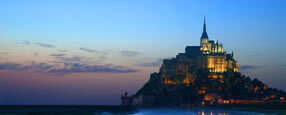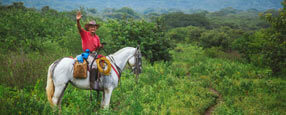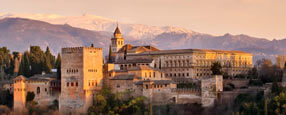CALL US: 1.800.665.3998
Idyllic Ireland
A small country with a big reputation, Ireland is everything you imagine and more rolling hills, cozy neighbourhood pubs, ancient mystical sites, rugged coastlines, spectacular mediaeval ruins and a warm, fun-loving people.
Duration: 11 days
Starts: Galway
Ends: Dublin
Highlights:
For pdf as printable itinerary: Click here
Starts: Galway
Ends: Dublin
Highlights:
Galway, rugged coastline of The Burren, the Cliffs of Moher, the Dingle Peninsula, the Ring of Kerry, Blarney Castle, Dublin, Belfast, Giant's Causeway
For pdf as printable itinerary: Click here
ITINERARY IN BRIEF
Day 1: Galway
On arrival at Shannon airport we are met and transferred to our hotel. En route we have included an orientation drive of Galway, passing Cathedral, Spanish Arch, City Museum, University and Cathedral of Our Lady. We then check into our hotel. Welcome meal at the hotel. Overnight Galway Bay & Country Club. Meal Plan: dinner
Day 2: Tralee via Dunguaire Castle and the Cliffs of Moher
Today we explore some of Ireland's most beautiful scenery. We drive to the rugged coastline of The Burren, where we view the Cliffs of Moher, visiting Dunguaire Castle in the picturesque village of Kinvarra en route. Dunguaire Castle was built in 1520 ACE by the O'Hynes clan on the picturesque shores of Galway Bay. The restored 16th-century tower house sits on a rocky outcrop on the shores of Galway Bay. After our short visit, we continue to The Cliffs of Moher. Towering over the sea at 214m at their highest point and stretching for more than five miles along the western seaboard of County Clare, the Cliffs of Moher are the iconic image of the Irish coastline. From the Cliffs, one can see the Aran Islands, Galway Bay, The Twelve Pins, the Maum Turk Mountains in Connemara and Loop Head way to the South. The Cliffs of Moher take their name from a ruined promontory fort "Mothar" which was demolished during the Napoleonic wars to make room for a signal tower. We continue to Tralee on the Dingle Peninsular and check into our historic castle hotel. Overnight Carlton Hotel (or similar). Meal Plan: breakfast, dinner
Day 3: Tralee - Dingle Peninsula
Once cited as 'the most beautiful place on Earth' by National Geographic, this mountainous finger of land jutting into the Atlantic Ocean has supported various tribes and populations for almost 6,000 years. In fact there is no other landscape in Western Europe with the density and variety of archaeological monuments as the Dingle Peninsulathe peninsula's remote location, and lack of specialized agriculture has helped to preserve over 2,000 historical monuments. Located in the southwestern part of County Kerry, Dingle has long been a favorite for travellers, and spans more than 20 miles of rugged green hills and golden sandy beaches. We pass through Dunquin, with its magnificent seascapes and cliffs, to visit the Blasket Centre located in Dún Chaoin, on the tip of the Dingle Peninsula. The centre celebrates the Blasket Islanders, the unique literary achievements of the island writers and their native language, culture and tradition. Sadly the Great Blasket was abandoned in 1953 as a result of the decline of its once vibrant population. Overnight Carlton Hotel (or similar). Meal Plan: breakfast, dinner
Day 4: Ring of Kerry, Skellig Interpretative Centre, Muckrose House
After an early breakfast, we depart for a full day touring through Ireland's most beautiful scenery. The unequalled Ring of Kerry, renowned as the most scenic drive in Ireland - and justly so, is our destination today. The views of Dingle Bay are softly spectacular in a way unique to the beautiful Emerald Isle. Behind the beauty lies a hard historyof famine, colonial suppression, resistance, and great pride. The Iveragh suffered terribly in the great potato famines of the 19th century, and many Americans can trace their roots to the great migrations of this period. We visit the Skellig Interpretative Centre which details the offshore Skellig Islands and is located on the waterfront in Valentia. Through re-creations and models we study the works and lives of the Skellig monks of the early Christian period as they gained a tenuous foothold on this tiny, inhospitable island and created a community that survived for some 600 years. We watch the16-minute audio-visual presentation that visually tells the story before we continue to Muckrose House. Muckrose House is located at Muckross Lake, nestling in the beautiful Kilarney National Park. Built by the Herbert family between 1839 and 1843 for Henry Herbert and his wife, the house was designed by William Burn. Today the house is furnished in period style and portrays the elegant lifestyle of the 19th-century landowning class, and the servant's quarters that made such a life possible. We then return to our hotel. Overnight Carlton Hotel (or similar). Meal Plan: breakfast, dinner
Day 5: Cashel via Blarney Castle & the Rock of Cashel
Today we drive to Cashel, stopping at Blarney Castle en route. Although fortified since 1210 CE, the current Blarney Castle was built 600 years ago by one of Ireland's greatest chieftains, Cormac MacCarthy, King of Munster, reputed to have sent to troops to help Robert the Bruce at the battle of Bannockburn in 1314 CE. The castle had a pivotal role during the Elizabethan age and during Oliver Cromwell's suppression of the Catholic rebellion during the English revolution. We have time for those who wish to kiss the Blarney Stone and gain 'the gift of the gab' - a term referring to the eloquence, lucidity and charm of the Irish. We then continue to Cashel. Like much of Ireland, Cashel has a rich history, including prehistoric raths, mediaeval monasteries and fortified town houses, a Georgian Cathedral and a 21st century Library (which holds regular exhibitions, workshops and concerts). The Georgian quarter also boasts the Bolton Library where you can find the smallest book in Ireland. On arrival at Cashel we visit the Rock of Cashel, the traditional seat of the Kings of Munster for several hundred years prior to the 1066 ACE Norman Invasion. The majority of surviving buildings date from the 12th and 13th centuries. Cashel is reputed to be the site of the conversion of the King of Munster by St. Patrick in the 5th century and, according to local mythology, the Rock of Cashel itself originated in the Devil's Bit, a mountain 20 miles to the north, transferred to its present location when St. Patrick banished Satan from a cave, resulting in the Rock's landing in Cashel. We visit the ruins then continue to our hotel. Overnight Dundrum House Hotel. Meal Plan: breakfast, dinner
Day 6: Dublin via Kilkenny Castle & Glendalaugh Visitor's Centrelin
Today we drive to Dublin, visiting first the eight-century-old Kilkenny Castle en route, which stands dramatically on the heights commanding the crossing of the River Nore and dominating the 'High Town' of Kilkenny. The original Anglo-Norman stone castle was built for William Marshal, 4th Earl of Pembroke during the first decade of the 13th century. Later the principal Irish residence of the powerful Butler family when James (c.1360-1405 ACE), 3rd Earl of Ormond, purchased the castle in 1391. For over 600 years the Butler family owned the estate, until 1967 when Arthur, 6th Marquess of Ormonde (1893-1971), presented it to the people of Kilkenny in return for a token payment of £50. We next visit the Glendalaugh Visitor's Centre, which has an interesting exhibition and audio-visual show depicting the early Christian ecclesiastical settlement founded by St. Kevin in the 6th century. The centre is adjacent to the monastic remains and graveyard which include a superb round tower, stone churches and decorated crosses, all set in a beautiful glaciated valley with two lakes. We then continue to Dublin and check in to our hotel. Overnight Wynn's Hotel. Meal Plan: breakfast
Day 7: Half-day walking tour of Dublin: Trinity College, Book of Kells, St. Patrick's
Today we take a walking tour of Dublin. We visit Trinity College, Dublin's famous 16th-century university which houses the famous Book of Kells. We next visit St Patrick's Cathedral, before continuing to the Guinness Storehouse at St James Gate for lunch (www.guinness-storehouse.com). After lunch we return to the hotel. The afternoon is at leisure. There is much to do. Those who wish a walk might visit the statue of the legendary Molly Malone, Davy Byrne's, a pub made famous by James Joyce in Ulysses, Dublin's smallest pub, the Dawson, and Temple Bar, Dublin's equivalent to Paris' Left Bank, and across the famous Ha'penny Bridge over the River Liffey to Dublin's main street and one of the widest boulevards in Europe, and a visit the General Post Office, HQ of the 1916 Rebellion. Ask your guide for route advice. Overnight Wynn's Hotel (or similar). Meal Plan: breakfast
Day 8: Dublin
Today is entirely at leisure to explore Dublin at your own pace. Dublin is best viewed on foot. Overnight Wynn's Hotel (or similar). Meal Plan: breakfast
Day 9: Belfast: Down Cathedral, St Patrick Centre, Falls Rd, Shankill
Today we drive into Northern Ireland, crossing a border of great historical significance in the island's history. We visit Down Cathedral, burial place of St Patrick. Tradition has it that Saint Patrick brought Christianity to Ireland in the early part of the fifth century ACE. Patrick was a North Briton captured by a raiding party and brought to Ireland as a slave. After six years of slavery he escaped and boarded a ship. But he had a dream that told him to return and take his faith with him. He did so, and Irish history changed forever. The main walls of the Cathedral date from after 1220 ACE, when the monks, in a petition to Henry III, King of England, referred to the House of Saint Patrick having been burned and was being rebuilt. Further destruction took place during the wars with Edward Bruce in 1316 ACE and finally, on the suppression of the monasteries in 1541 ACE, the Cathedral was laid waste. Although successive deans continued to be installed within the ruined walls, there were no funds to rebuild the Cathedral until 1790 ACE when Wills Hill, the Earl of Hillsborough provided the funds to commence the restoration. We continue to Belfast. On arrival we visit the Victorian Buildings, the Harland & Wolf Dockyards, and the Falls Road and Shankill residential areas which was the front line in the struggle for Irish independence. Overnight Wellington Park Hotel. Meal Plan: breakfast, lunch, dinner
Day 10: Kingscourt via Carrickfergus Castle & Giant's Causeway
Today we drive to Kingscourt via Carrickfergus Castle and the surreal and dramatic Giant's Causeway. Carrickfergus Castle is located just north of Belfast on the coast overlooking Belfast Lough. Construction was started by John de Courcy around 1180 ACE, as a part of the Norman Anglo invasion of Ireland. Troops continued to be garrisoned at the Castle to the end of the First World War, and the castle was decommissioned in 1928. The restoration reflecting the castle's turbulent 820-year history is charming. We continue to the Giant's Causeway. Often described as the 'Eighth Wonder of the World,' the causeway was declared Ireland's first World Heritage site by UNESCO in 1986. Located on the north coast two miles north of Bushmills, the causeway is an area of approximately 40,000 interlocking basalt columns, the result of an ancient volcanic eruption during the Tertiary period, some 50-60 million years ago. The columns were formed as a result of repeated outpourings of volcanic basalt. However, before science discovered factual explanations, religions, legends and fables were invented to help explain our world, and many remain convinced that the causeway's origins lie in the legend. The Giant's Causeway's legend is that the Irish giant Finn fell asleep before crossing to Scotland on the causeway that crossed the sea and joined the two kingdoms. He woke up to find Benandonner, a Scottish giant, on the other side looking at him and preparing to come to Ireland. Finn realised Benandonner was much bigger than he was and would win any battle, so he ran to his wife Oonagh to ask what he should do. Oonagh disguised Finn as a baby and put him in an enormous cradle. Benandonner saw the huge 'child' in the cradle and wondered how big his father was. Having second thoughts, Benandonner returned to Scotland and destroyed the Causeway as he returned home. What remains of this sea crossing bridge is today's Giant's Causeway, and many today still prefer their faith and the legend to the factual illumination of science. And who can blame them? We continue to our hotel. Overnight Cabra Castle Hotel. Meal Plan: breakfast, lunch, dinner
Day 11: Depart from Dublin
Today we drive back to Dublin in time for our departure flight OR onward flight to London to join the five day London extension itinerary. Meal Plan: breakfast
LOOKING FOR INSPIRATION?







